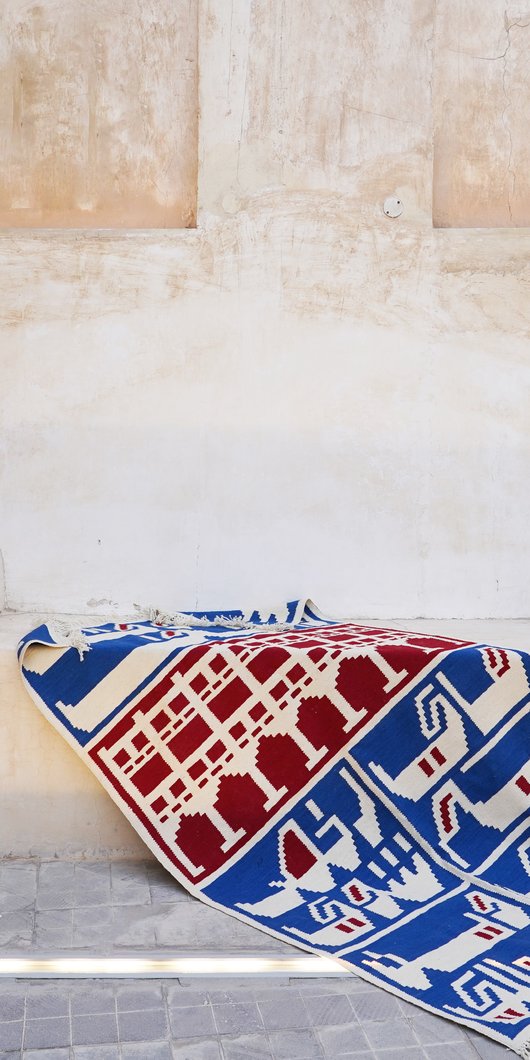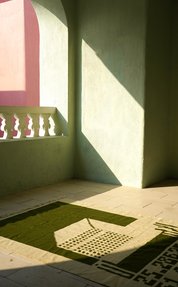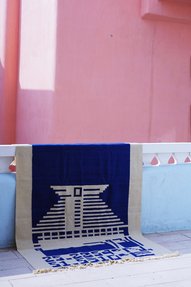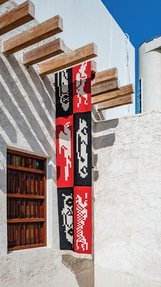Maryam, what was your introduction to textiles, or your first encounter with a textile that had an impact on you?
From a young age I’ve always had a heightened sensitivity to materiality, especially in textiles, [and] the prints and the embroidery that goes with them. My grandmother often wears jalabiya garments adorned with unique embroideries – from colourful threads to beads and artificial pearls – that beautifully complement the jalabiya graphic patterns. I’ve consistently found myself captivated by the intricate details of these garments.
Was there a pivotal moment in your life or career that made you realise the importance of preserving and archiving textiles, be it the visual languages embedded in them or the process of creating a textile – from harvest and dyeing to weaving and tatreez?
For me, archiving extends beyond textiles. I find tangible outputs, ones we can touch, feel and truly appreciate, more effective [. . .] While textile art holds a unique allure, with its intricate weaving, dyeing and various techniques contributing to its craft, there’s a special quality in its ‘slowness’. This deliberate pace adds value and appreciation to whatever memory, image, word or shape we aim to showcase and preserve.
Why is it important for you to document and archive through textile?
While the weaving process embraces the ‘slowness’ that adds value and depth to the archiving process, my documentation of Qatar’s dynamic landscape captures modern society’s immediacy and rapid evolution. The juxtaposition between these two approaches, the slowness documenting the rapidness, reflects the appreciation of the multifaceted nature of preserving and representing culture in the face of constant change. The deliberate pace of weaving becomes a contemplative counterpoint to the fast-paced rhythm of my documentation, emphasising the importance of both in capturing the essence of a place and time.
What is your favourite local or regional textile [either today] or of all time? Why?
The array of fabric prints [and their hybrid designs] at our local souq, influenced by multicultural trade, captivates me. Despite lacking designer signatures, these pieces, imported from India, South Korea, Japan and China over the years, are cherished locally, having become ingrained in our Qatari culture.
Who has been your most prominent teacher in textile design and art?
My most prominent teachers are travelling, time and experience. I engage in extensive visual exploration of textile and graphic arts, particularly during my travels. I draw inspiration from international brands like Marimekko [a Finnish design house] and local resources, observing the vibrant scenes in the souq, exploring Sadu traditions and admiring the intricate embroidery on my grandmother’s jalabiyas.
What is the most significant impact that the legacy of a textile design has had on you?
Exploring textile art has heightened my appreciation for the intricacies and beauty inherent in the creation process. While I engage in my textile work, collaborating with weavers worldwide has revealed the thoughtful and beautiful aspects of the weaving process. The deliberate pace and handmade imperfections, coupled with the fascinating continuity of techniques passed from generation to generation, captivate me, especially in the context of technological advancements.
How does textile design contribute to culture? To community?
Utilising it as a means of documentation, I aim to remind the community that there’s beauty in construction and destruction, finding the intricate beauty in every detail that surrounds us. Having textiles be part of the history of the country and the region, specifically in today’s world when things are rapidly changing, and we tend to forget these details and stories because of the nature of our current fast-paced life.
How has the legacy of a local or regional textile informed a project you have worked on or [how has it] informed your practice at large?
The technique significantly shapes many of my aesthetic choices. Typography is crafted to complement the weaving technique, and colour palettes and certain motifs are intricately designed in harmony with it.
How has your relationship with textiles changed over time?
I became more appreciative of the craft and the techniques I am exposed to that come from various parts of the world.
How do we honour (and maybe even modernise) a textile while trying to archive and preserve its historical, environmental and sociopolitical context?
Rather than modernising the technique, which has held its intrinsic value over thousands of years, I prefer to contemporise it by playing with graphics and infusing a modern message while preserving its precious, timeless essence. This approach allows for a delicate balance between honouring tradition and expressing the relevance of the craft in today’s context.
As a designer, what obstacles have you observed or faced in learning about and archiving a textile?
Manufacturing cost and accessibility.
From a very young age, you were exposed to and were embedded in Qatar’s arts and culture scene through your dad, Yousef Ahmad Al Homaid, a pioneer of the art world in Qatar. In a previous interview, you shared photographs of you as a young girl at openings of his shows and in the classrooms [where] he taught. Can you tell us a little about these experiences? Did you immediately know this was a world you wanted to contribute to? How did it shape your understanding of the role of artistic expression in archiving cultural heritage?
Creating art is not just a pastime; it’s an integral part of my lifestyle. I cannot fathom my identity and existence without it. My father’s studio has always been and continues to be my playground. What intrigued me the most, and what I draw inspiration from, is the way my father used Qatar and the surrounding region as the cornerstone of his work. He delved into exploration through various mediums and techniques, whether it be prints, paintings, sculptures, etc.
I didn’t initially recognise that my immediate environment could serve as a wellspring of inspiration during that period. My perspective was oriented towards finding inspiration beyond the region – Japanese art, Western art, etc. However, it wasn’t until my 20s that I realised the significance of looking inwards and exploring my [own] landscape for inspiration. This realisation marked a pivotal moment where I understood the importance of archiving the cultural heritage embedded in my surroundings.
How did your beginnings in design and archiving take shape? How did you begin to create as an artist and a designer?
My journey into design and archiving began as an innate part of my identity. From my earliest memories, I used my father’s studio as a playground, spending countless afternoons sketching, drawing and colouring. What started as a hobby quickly evolved into a lifestyle, a passion that has endured throughout the years. Journaling, drawing, creating fan art of musicians and actors, and mimicking various typography styles became integral to my artistic exploration.
The recent tapestry work [that I created has] fuelled my artistic curiosity and shaped my visual language. It laid the foundation for a journey that seamlessly transitioned from childhood pastimes to attending a design school that recognised and celebrated my artistic inclinations. Through this continuous evolution, I have found joy and purpose in bringing together diverse elements, specifically parts related to archiving the current transformative nature of Qatar and the region.
As a multidisciplinary artist and designer, you use a plethora of mediums to create your work, ranging from the digital world to plastic or material arts. How does your multimedia practice materialise in your textile design and art? What does your process look like?
While I engage with various mediums, a cohesive visual language ties them together. My aesthetics consistently feature[s] limited colour palettes, bold forms and contemporary typography across all mediums. I start by making a lot of visual documentation through sketching, photography or writing. I then transform my ideas digitally using reference materials and keeping in mind the weaving process, as the aesthetics must complement the making to create a cohesive outcome.
When did you start to work with textiles, and why?
I embarked on my textile journey approximately 16 years ago through my involvement in a research project led by one of my professors. This project delved into textile design, incorporating my personally crafted pixel-based graphics. Initially designed on a small scale, these graphics were later expanded into a tangible medium. The transformative process from digital to tangible ignited my passion for textile design (and other physical outcomes), inspiring me to continue and explore further in this creative domain.
Your textile design work is informed by the different aspects of Qatari life, as if you are creating a live archive. Was this your intention? Where do you see your textile design work going and evolving?
Indeed, my intention has always been to archive the rapidly changing landscape of Doha, Qatar, encompassing all its facets, from architecture and language to lifestyles and more. I envision my textile work evolving into a collection of informative pieces that bear the stories of Qatar and its people (locals and nonlocals). These pieces serve as a means to enlighten the world about our identity and the remarkable transformations we are experiencing. They are not merely textiles but narratives woven with threads that reflect the vibrant tapestry of our cultural evolution.



